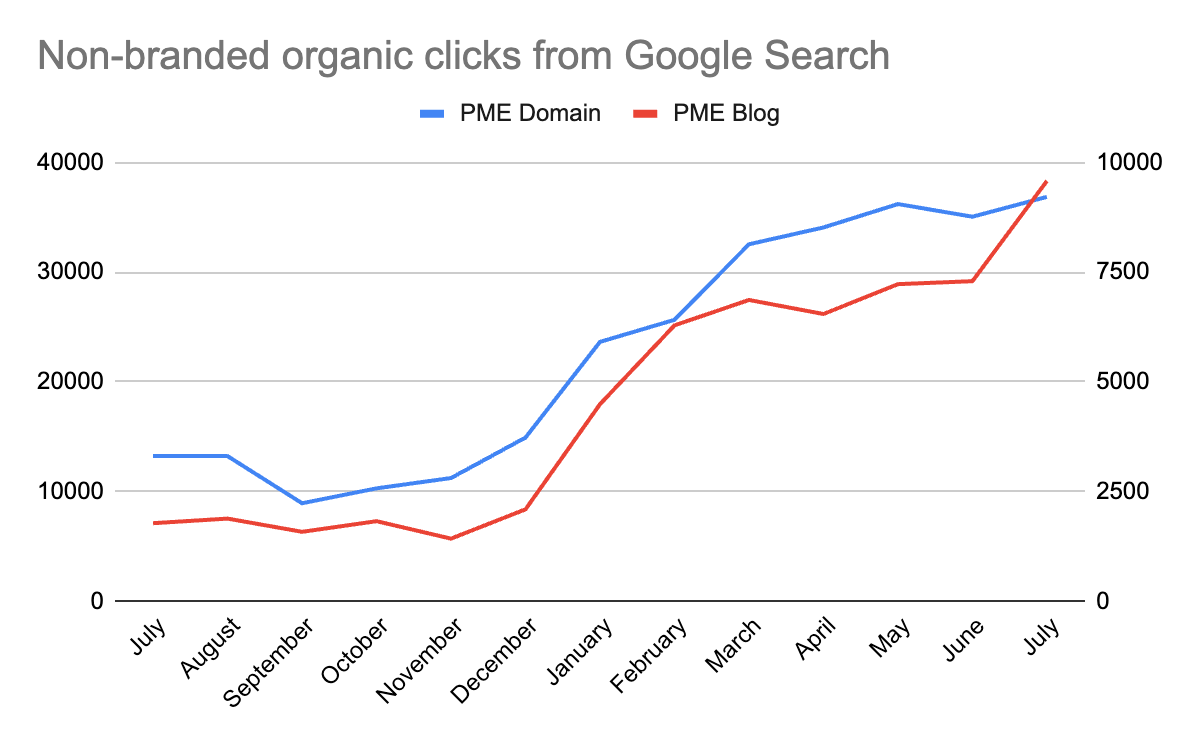Content performance at Proton
Growing non-branded organic traffic for Proton
Created: July 2022
In July 2022, it was established that although Proton received a lot of organic traffic to both its websites (proton.me and protonvpn.com), this traffic was predominantly driven by branded searches. This represented an opportunity for Proton to educate more users by capturing non-branded search traffic and convert them from problem-aware users to product-aware customers.
By pursuing an SEO content strategy that targeted relevant search queries with human, genuinely useful content that demonstrated Proton’s expertise, I was able to grow proton.me’s non-branded search traffic by 178% in one year at the domain level. Over the same time period, proton.me’s blog saw an increase in non-branded search traffic of 437%.
I took the same approach with Proton’s secondary website, protonvpn.com, although this website was already ranking for some very large non-branded search queries such as “free vpn” and even “vpn” alone, so the problem was not as acute at the domain level. Proton VPN’s website saw a 67% increase in traffic over one year, whereas the Proton VPN blog’s non-branded search traffic increased by 536%.
The problem
Proton is a Swiss technology company that created Proton Mail, Proton VPN, Proton Calendar, Proton Drive, and Proton Pass. The company runs two websites, proton.me (for Mail, Calendar, Drive, and Pass) and protonvpn.com (for VPN). Since Proton’s beginnings as a kickstarter campaign in the wake of the Snowden revelations, it has been able to rely on its brand recognition and third-party websites to drive traffic to the two websites.
Proton VPN also provides a high-value free VPN service which is arguably the best on the market. As such, it was ranking for a handful of high-volume “free vpn”-related search queries in the top three positions for the relevant SERPs, which delivered a huge amount of non-branded traffic to the website. Outside of these head terms, the website was not capturing non-branded organic traffic.
However, this approach to acquisition meant that a large portion of non-branded search traffic was not being captured and directed to the website. There was no SEO strategy in place, so any non-branded organic traffic that the website received was largely accidental.
The solution
I conducted in-depth keyword research and competitor research to establish traffic-driving topics for our industry. I maintained a narrow view of what would be acceptable content for the Proton websites, as our brand and voice are particularly important to our existing audiences who read our blog posts in large numbers. For example, while some keywords with large search volumes were tangentially related to Proton’s products, many were ultimately disregarded if they were not deemed to be useful to our existing audience as well as new users.
All keywords from this exercise were then mapped to either existing pages or new pages and blog posts that then were used to create a year-long SEO content calendar. This calendar contained the topic for each landing page or blog post, the keywords, word counts, author, and necessary internal links.
The SEO content calendar was assessed every month and tweaked where necessary. It was my role to write briefs for each entry on the calendar and assign them to either in-house writers, freelance writers, or write the pieces myself. I also tracked the production of each piece and delivered updates to the relevant stakeholders. At the end of every month I assessed each entry’s performance and returned to optimise the blog posts or landing pages that were not performing as well as we’d hoped.
I delivered monthly reports to the stakeholders of each product and the company C-suite. As SEO needs some time to begin showing results, it was my responsibility to get stakeholder buy-in and commitment to the SEO content project, which was admittedly resource intensive.
Results
Results
By all measurements, non-branded organic traffic has significantly increased as a direct result of this project. It was harder to move the needle for the Proton VPN domain, as large volumes were already being delivered by existing rankings.
Proton.me domain: +178%
Proton.me blog: +437%
Protonvpn.com domain: +67%
Protonvpn.com blog: +536%
The results for this project were tracked across multiple tools, including Google Search Console, ahrefs, and Proton’s own internal bespoke tracking tools.
By the end of June, there had been 102 items published from the content calendar which had received 1,112,570 total visits and 233,156 organic visits. Of these 102 items, 81 of them rank for their primary keyword, and 40 are ranking on page one of Google in the US for their primary keyword.
Note: This does not count posts that rank highly for extremely relevant keywords such as the blog post What is PGP encryption and how does it work?, which ranks #12 for its primary keyword “what is pgp”, but ranks #1 for “how does pgp work”. So the number of posts that rank on page one of Google for a relevant keyword is much higher.
Want to know more?
Get in touch using the form below and we can talk about this project (or anything else you want to know) in more depth. Pop the kettle on and let’s have a chat.


